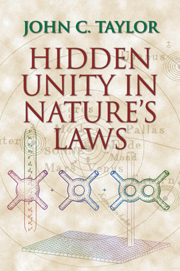Book contents
- Frontmatter
- Contents
- Preface
- 1 Motion on Earth and in the Heavens
- 2 Energy, Heat and Chance
- 3 Electricity and Magnetism
- 4 Light
- 5 Space and Time
- 6 Least Action
- 7 Gravitation and Curved Spacetime
- 8 The Quantum Revolution
- 9 Quantum Theory with Special Relativity
- 10 Order Breaks Symmetry
- 11 Quarks and What Holds Them Together
- 12 Unifying Weak Forces with QED
- 13 Gravitation Plus Quantum Theory – Stars and Black Holes
- 14 Particles, Symmetries and the Universe
- 15 Queries
- APPENDIX A The Inverse-Square Law
- APPENDIX B Vectors and Complex Numbers
- APPENDIX C Brownian Motion
- APPENDIX D Units
- Glossary
- Bibliography
- Index
7 - Gravitation and Curved Spacetime
Published online by Cambridge University Press: 20 January 2010
- Frontmatter
- Contents
- Preface
- 1 Motion on Earth and in the Heavens
- 2 Energy, Heat and Chance
- 3 Electricity and Magnetism
- 4 Light
- 5 Space and Time
- 6 Least Action
- 7 Gravitation and Curved Spacetime
- 8 The Quantum Revolution
- 9 Quantum Theory with Special Relativity
- 10 Order Breaks Symmetry
- 11 Quarks and What Holds Them Together
- 12 Unifying Weak Forces with QED
- 13 Gravitation Plus Quantum Theory – Stars and Black Holes
- 14 Particles, Symmetries and the Universe
- 15 Queries
- APPENDIX A The Inverse-Square Law
- APPENDIX B Vectors and Complex Numbers
- APPENDIX C Brownian Motion
- APPENDIX D Units
- Glossary
- Bibliography
- Index
Summary
How Einstein discovered that what we think of as gravitational force is nothing but an effect of geometrical curvature of spacetime.
The Problem
In 1906, Einstein, having the previous year explained Brownian motion (see Appendix C), invented his special theory of relativity (see Chapter 6) and, having begun the quantum theory of light, was promoted to technical expert second class in the patent office at Bern. In 1907 he began his great struggle to create a new theory of gravity, which culminated in his “general theory of relativity” in 1915.
Why was Einstein dissatisfied with Newton's theory of gravity? It had agreed with observations for more than two hundred years, predicting, for example, the existence of the planet Neptune (the work of Adams and Leverrier), which was discovered in 1846. There was one exception: a small discrepancy in the orbit of Mercury, announced by Leverrier in 1859. Several attempts had been made to explain this (for example, as due to a planet, Vulcan, between Mercury and the Sun), but none was generally accepted. So far as I know, this problem with Mercury was not important in motivating Einstein.
Einstein saw two problems with Newtonian gravity (Chapter 1). First: it was not consistent with Einstein's special theory of relativity – his account of spacetime. Second: it offered no explanation of the equality of inertial and gravitational mass (see Section 1.7). I will explain these two points in turn.
In Newton's theory, gravity is transmitted instantaneously; indeed the theory is formulated in the context of an absolute time.
- Type
- Chapter
- Information
- Hidden Unity in Nature's Laws , pp. 191 - 213Publisher: Cambridge University PressPrint publication year: 2001



